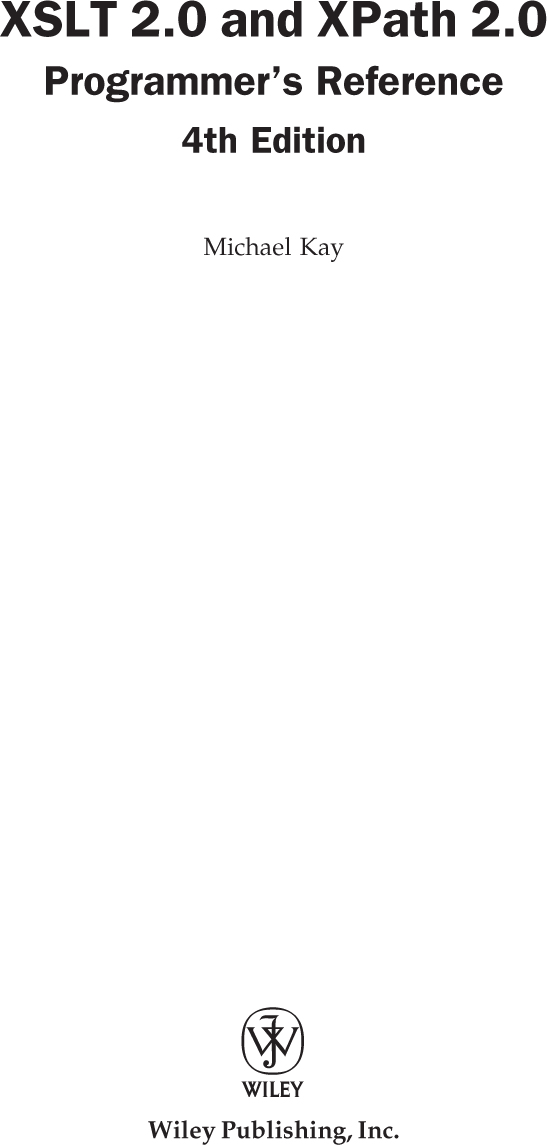XSLT 2.0 and XPath 2.0 Programmer's Reference, 4th Edition (2 page)
Read XSLT 2.0 and XPath 2.0 Programmer's Reference, 4th Edition Online
Authors: Michael Kay

Chapter 11: XPath: Type Expressions
Chapter 13: The Function Library
Chapter 14: Regular Expressions
What Vendor Extensions Are Allowed?
Chapter 17: Stylesheet Design Patterns
Fill-in-the-Blanks Stylesheets
Chapter 18: Case Study: XMLSpec
Formatting the XML Specification
Formatting the Document Header
Creating the Table of Contents
Setting Out the Production Rules
Stylesheets for Other Specifications
Chapter 19: Case Study: A Family Tree
Displaying the Family Tree Data
Chapter 20: Case Study: Knight's Tour
Appendix A: XPath 2.0 Syntax Summary
Appendix C: Backward Compatibility
Stage 1: Backward-Compatibility Mode
Stage 2: Setting version=“2.0”
Appendix D: Microsoft XSLT Processors
Appendix E: JAXP: The Java API for Transformation
Examples of JAXP Transformations
Using Saxon from the Command Line
Using Saxon via JAXP Interfaces

XSLT 2.0 and XPath 2.0 Programmer's Reference 4th Edition
Published by
Wiley Publishing, Inc.
10475 Crosspoint Boulevard
Indianapolis, IN 46256
Copyright © 2008 by Wiley Publishing, Inc., Indianapolis, Indiana
Published simultaneously in Canada
ISBN: 978-0-470-19274-0
Library of Congress Cataloging-in-Publication Data is available from the publisher.
No part of this publication may be reproduced, stored in a retrieval system or transmitted in any form or by any means, electronic, mechanical, photocopying, recording, scanning or otherwise, except as permitted under Sections 107 or 108 of the 1976 United States Copyright Act, without either the prior written permission of the Publisher, or authorization through payment of the appropriate per-copy fee to the Copyright Clearance Center, 222 Rosewood Drive, Danvers, MA 01923, (978) 750-8400, fax (978) 646-8600. Requests to the Publisher for permission should be addressed to the Legal Department, Wiley Publishing, Inc., 10475 Crosspoint Blvd., Indianapolis, IN 46256, (317) 572-3447, fax (317) 572-4355, or online at
http://www.wiley.com/go/permissions
.
Limit of Liability/Disclaimer of Warranty:
The publisher and the author make no representations or warranties with respect to the accuracy or completeness of the contents of this work and specifically disclaim all warranties, including without limitation warranties of fitness for a particular purpose. No warranty may be created or extended by sales or promotional materials. The advice and strategies contained herein may not be suitable for every situation. This work is sold with the understanding that the publisher is not engaged in rendering legal, accounting, or other professional services. If professional assistance is required, the services of a competent professional person should be sought. Neither the publisher nor the author shall be liable for damages arising herefrom. The fact that an organization or Website is referred to in this work as a citation and/or a potential source of further information does not mean that the author or the publisher endorses the information the organization or Website may provide or recommendations it may make. Further, readers should be aware that Internet Websites listed in this work may have changed or disappeared between when this work was written and when it is read.
For general information on our other products and services please contact our Customer Care Department within the United States at (800) 762-2974, outside the United States at (317) 572-3993 or fax (317) 572-4002.
Trademarks
: Wiley, the Wiley logo, Wrox, the Wrox logo, Wrox Programmer to Programmer, and related trade dress are trademarks or registered trademarks of John Wiley & Sons, Inc. and/or its affiliates, in the United States and other countries, and may not be used without written permission. All other trademarks are the property of their respective owners. Wiley Publishing, Inc., is not associated with any product or vendor mentioned in this book.
Wiley also publishes its books in a variety of electronic formats. Some content that appears in print may not be available in electronic books.
To Anyone Who Uses This Book
To Make the World a Better Place
About the Author
Michael Kay
has been working in the XML field since 1997; he became a member of the XSL Working Group soon after the publication of XSLT 1.0, and took over as editor of the XSLT 2.0 specification in early 2001. He is also a member of the XQuery and XML Schema Working Groups, and is a joint editor of the XPath 2.0 specification. He is well known not only through previous editions of this book but also as the developer of the open source Saxon product, a pioneering implementation of XSLT 2.0, XPath 2.0, and XQuery 1.0.
In 2004 the author formed his own company, Saxonica, to provide commercial software and services building on the success of the Saxon technology. Previously, he spent three years with Software AG, working with the developers of the Tamino XML server, an early XQuery implementation. His background is in database technology: after leaving the University of Cambridge with a Ph.D., he worked for many years with the (then) computer manufacturer ICL, developing network, relational, and object-oriented database software products as well as a text search engine, and held the position of ICL Fellow.
Michael lives in Reading, England, with his wife and daughter. His hobbies (reflected in his choice of examples) include genealogy and choral singing, and once included chess. Since completing the previous edition he has found time to improve his croquet handicap to 6.
 instance of
instance of Operator
Operator